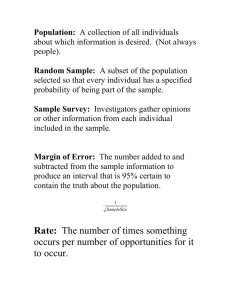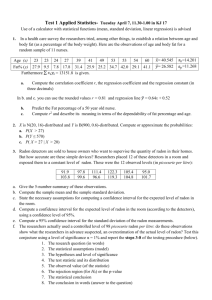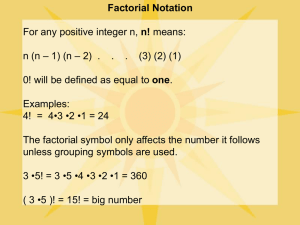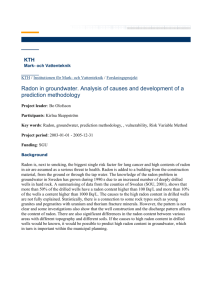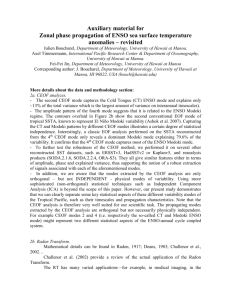Notes of 9
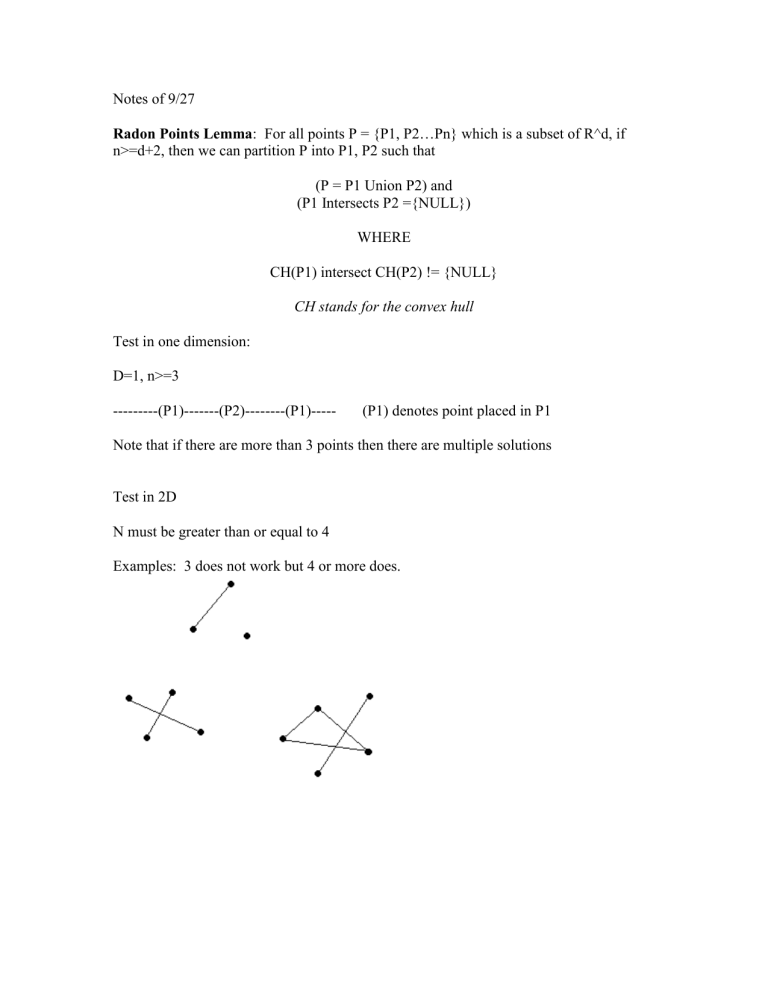
Notes of 9/27
Radon Points Lemma : For all points P = {P1, P2…Pn} which is a subset of R^d, if n>=d+2, then we can partition P into P1, P2 such that
(P = P1 Union P2) and
(P1 Intersects P2 ={NULL})
WHERE
CH(P1) intersect CH(P2) != {NULL}
CH stands for the convex hull
Test in one dimension:
D=1, n>=3
---------(P1)-------(P2)--------(P1)----- (P1) denotes point placed in P1
Note that if there are more than 3 points then there are multiple solutions
Test in 2D
N must be greater than or equal to 4
Examples: 3 does not work but 4 or more does.
Now suppose:
P1={P1….Pk} P2={P(k+1), Pn} a1 …. ak
bk+1 …. bn
Summation a(sub)i=1 where a(sub)i>= 0 Summation b(sub)i=1 where b(sub)i>= 0
C = summation a(sub)i * pi C = summation a(sub)i * pi
C is an element of CH(P1) C is an element of CH(P2)
Now construct vectors:
P1= p11
.
.
.
p1d
P2= p21
.
.
.
p2d
Pn= pn1
.
.
.
pnd
n
1 1 . ……………………. . . 1 p11 p21………………………. pn1 x1
. . ………………………….. x2
. . ………………………… . ============ (0)
. . . ………………………… .
. . …………………………. . p1d p2d ……………………..pnd xn
This must have a solution that is non-trivial i.e. x1…..xn not equal to 0
The solution of this linear system means x1 +x2 + x3 … + xn = 0 and each xi !=0 which means the summation of a + b =0 and x1p1 + x2p2 +…………+ xnpx = 0
In this case there must obviously be one component that is positive and another that is negative since all the xs cannot be 0, there must be a negative to cancel out any positives and vice versa.
Define P1 to be the set of all ps that are positive or 0s
Define P2 to be the set of all ps that are negative
Claim: This partition satisfies radon.
I1= { i: xi > = 0)
I2= { i: xi > = 0)
Summation of xi = Summation (-xj) = Q i is element I1 j is element I2 ai = xi/Q bj = xj/Q sum where x is an element of I1 xi/Q * pi = sum where x is an element of I2 xi/Q * pj
So this is a combination where
C = sum ai*pi C = sum bj * pj
Thus C = Q
The time for this is O( d^3)
Proof of Helly’s Theorem:
This will be a proof by induction on n.
Base Case: If n= d +1 then this is trivial. If all the hulls intersect with each other then every one intersects with every other at at least one point so they all obviously intersect.
Induction:
Assume Helly’s theorem holds true for all points up to n – 1 and that n >= d+2.
Given this let p(sub)j be the intersection of i and j (where i != j) in Ci. So basically this is the intersection of everything in the set not including j.
So we build a set of these ps in where P={p1, p2….pn}. By radon which was just proven above we can partition P so that their Convex Hulls intersect somewhere. So we partition P into P1 and P2. q is an element of CH(P1) intersect CH(P2) q is an element in the intersection of the convex hulls of the partitions which was proven to exist by radon.
Now if we prove that q is an element of Cj for all js then we have proven that there is a point where all the hulls intersect.
Assume some element pj is an element of P1. And that P2={ p1 bar, p2 bar,…. Pk bar}.
Claim: P2 belongs to Ci because in creating pj pj is the only element that does not belong to Cj.
This means Cj is not empty.
Middle of Three:
We can use radon to convert middle of 3 to middle of d+2.
The probability that s is not a beta center point is 1/ (d choose 2) – center point.
Now suppose one chooses a direction they want to project on. If we project all points to that projection we can then choose 4 points at random and determine a radon point based on that.
We then conduct a tail analysis on this. Half or more of the points must be in the tail for the radon point to be in the tail. This is because the radon point is in the middle and for the middle to be in the tail at least half the points must be in the tail.
In the first level of the tree, the probability that a point lands in an area less than or equal to x is x. So the probability that it lands in the tail is the size of the tail.
In the second level of the tree, we are dealing with 4 points and as such at least 2 must be in the tail for the radon point to be in the tail. So this probability is less than the first levels.
If we continue this the probability bounds at ((d+2) choose 2) * X^2.
At the third level, the probability is ((d+2) choose 2) * probability that the second level < X.
This is ((d+2) choose 2) *((d+2) choose 2) *X^4
Continuing this we can see that the probability that a radon point is in the tail on every level is:
<= (((d+2) choose 2) ^(1+2+4…2^h) ) * (X^2^h) at level h.
This reduces to:
X<1/((d+2) choose 2)
From linear programming we only have to worry about n choose d directions so the probability is
(n choose d)* 1/((d+2) choose 2)
Sampling can simplify this even further.


